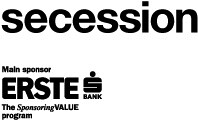Fernanda Gomes
Martine Syms: Boon
April 12–June 16, 2019
Friedrichstraße 12
1010 Vienna
Austria
Hours: Tuesday–Sunday 10am–6pm
T +43 1 587530710
F +43 1 587530734
presse@secession.at
The Vienna Secession is pleased to announce the exhibitions by Peter Doig, Fernanda Gomes and Martine Syms.
Peter Doig
The artist is showing entirely new work in his exhibition at the Secession. Doig continues to explore recurring motifs that have appeared throughout his recent work, drawing from the physical and cultural landscape that surrounds him in Trinidad where these works were made.
Doig paints the cacophony of downtown Port of Spain’s streetscapes, cameos are made by late, legendary calypsonian, The Mighty Shadow. In another recurring scene, with references to Giorgio di Chirico and Vincent van Gogh’s The Yellow House, lions prowl the perimeter of the yellow walled Port of Spain prison on Fredrick Street. A man paints by moonlight within walls of the prison Carrera, set on the island by the same name, that has past appearances in Doig’s work.
Doig returns to his 2017 homage to Marsden Hartley—a depiction of Robert Mitchum on a beach in Trinidad—but now Mitchum is nearly unrecognizable, an abstraction that allows Doig to experiment in paint handling and image-making.
Elsewhere, a balcony looks out onto a clouded forest and the scenic bays and dense bush that surround Doig’s home. Beyond, vistas of Paramin on the north coast of Trinidad can be made out. The dark night opens onto the vast, unobstructed sea.
Friends, neighbors, loved ones, strangers make appearances in Doig’s pictures, animating landscapes, and moody seascapes where his personal biography is intertwined with the lives of others lead and observed nearby.
With these recurring motifs, Doig continually challenges himself to paint in ways that are radically different from his previous, connected paintings.
Peter Doig was born in Edinburgh in 1959 and raised in Trinidad and Canada before moving to London in 1979 to study painting. He currently lives and works in New York and Trinidad.
Fernanda Gomes
Since the 1980s, the Brazilian artist Fernanda Gomes has used ordinary and affordable materials to make objects and bricolages (always untitled) whose formal idiom recalls Arte Povera, minimalism, and Brazilian constructivism. Her exhibitions often consist of an abundance of objects scattered across the floor and walls, gathered in clusters or rhythmically organized arrangements. Leftovers and lost, disregarded, or discarded items as well as commonplace objects are arranged in the space, assembled in fragile and precarious constructions or consolidated and corded for more compact creations. The only paint the artist uses is white, which she cherishes as the “receptive colour,” revealing even the subtlest shifts in the tonality and intensity of the light.
Fernanda Gomes explores the characteristic qualities of a setting—the lighting, proportions, the materials, etc.—both through careful observation and by allowing them to affect her on a visceral level. Empty spaces, the artist believes, are not vacant; on the contrary, they teem with information. Both the placement and the constructive execution of her works respond to the exhibition space.
At the Secession, Fernanda Gomes will apply her usual approach of letting a space and situation reverberate with her: “much of the process is purely mental, and unpredictable. each exhibition is a piece in itself, created from the perspective of a given situation. the core of the action is to produce a state of being, thinking, feeling, moving, also to produce joy. i love arriving with bare hands, bringing nothing for an exhibition, having no transportation, no artworks. it still gives me the thrill, the lightness of the many possibilities, of everything open and fresh. it confirms, once more, the immateriality of the essence of things. when words fade out, the game starts seriously. to play with things is maybe the first language we know. before the word there is the world, intact in its mystery and fascination.”
Fernanda Gomes was born in Rio de Janeiro in 1960 and lives and works in Rio de Janeiro.
Martine Syms, Boon
Martine Syms uses video, installation, and performance to examine representations of blackness and its relationship to vernacular, feminist thought, and radical traditions. Her research-based work draws on her extensive studies of theoretical models concerned with performed or imposed identities, the power of the gesture, and embedded assumptions around gender and racial inequalities.
For the Secession, Syms has created an immersive installation comprised of a sculptural intervention, a sound installation, and a photographic collage, with each element referencing the Detroit-based Simpson’s Record Shop. Expanding on Syms’s interest in black-owned businesses as sites of interdependence and self-determination, the new work highlights the store as one such business. Boon pays tribute to the enterprise and creative energy with which Dorothy Simpson ran the record store, a center of the local community’s cultural, social, and economic life and gathering spot for its residents, from 1966 until 2018.
Syms’s interest in Detroit stems from its position as a long-standing hub of black culture and life, and is as multifaceted as her works, which are characterized by the weaving of fictional strands and (autobiographical) facts into hybrid narratives. Detroit was not only the home of the legendary Motown record label; the city’s dominant automobile industry also made it a key destination of the 20th century’s “Great Migration,” during which around six million blacks moved from the agrarian South to the industrialized Northeast, Midwest, and West. With the decline of American manufacturing, the more recent past has seen Detroit undergo equally dramatic changes, from the hollowing-out of black neighborhoods to the emergence of gentrifying presences within the city. The work also allows Syms to reflect on the history of her own family, who arrived in Los Angeles by way of Detroit.
Martine Syms was born in Los Angeles in 1988 and lives and works in Los Angeles.
An artist’s book is published in conjunction with each exhibition.
The exhibition program is conceived by the board of the Secession.


